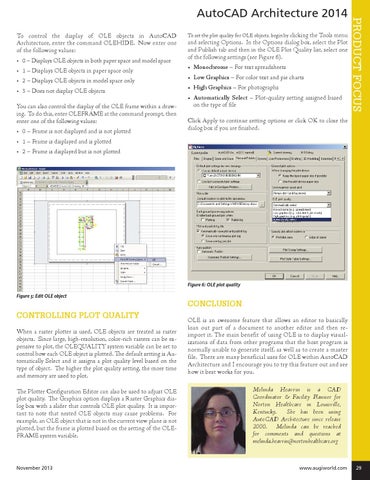To control the display of OLE objects in AutoCAD Architecture, enter the command OLEHIDE. Now enter one of the following values: • 0 – Displays OLE objects in both paper space and model space • 1 – Displays OLE objects in paper space only • 2 – Displays OLE objects in model space only • 3 – Does not display OLE objects You can also control the display of the OLE frame within a drawing. To do this, enter OLEFRAME at the command prompt, then enter one of the following values: • 0 – Frame is not displayed and is not plotted
To set the plot quality for OLE objects, begin by clicking the Tools menu
and selecting Options. In the Options dialog box, select the Plot and Publish tab and then in the OLE Plot Quality list, select one of the following settings (see Figure 6). • Monochrome – For text spreadsheets • Low Graphics – For color text and pie charts • High Graphics – For photographs • Automatically Select – Plot-quality setting assigned based on the type of file
PRODUCT FOCUS
AutoCAD Architecture 2014
Click Apply to continue setting options or click OK to close the dialog box if you are finished.
• 1 – Frame is displayed and is plotted • 2 – Frame is displayed but is not plotted
Figure 6: OLE plot quality Figure 5: Edit OLE object
CONTROLLING PLOT QUALITY When a raster plotter is used, OLE objects are treated as raster objects. Since large, high-resolution, color-rich rasters can be expensive to plot, the OLEQUALITY system variable can be set to control how each OLE object is plotted. The default setting is Automatically Select and it assigns a plot quality level based on the type of object. The higher the plot quality setting, the more time and memory are used to plot. The Plotter Configuration Editor can also be used to adjust OLE plot quality. The Graphics option displays a Raster Graphics dialog box with a slider that controls OLE plot quality. It is important to note that nested OLE objects may cause problems. For example, an OLE object that is not in the current view plane is not plotted, but the frame is plotted based on the setting of the OLEFRAME system variable.
November 2013
CONCLUSION OLE is an awesome feature that allows an editor to basically loan out part of a document to another editor and then reimport it. The main benefit of using OLE is to display visualizations of data from other programs that the host program is normally unable to generate itself, as well as to create a master file. There are many beneficial uses for OLE within AutoCAD Architecture and I encourage you to try this feature out and see how it best works for you. Melinda Heavrin is a CAD Coordinator & Facility Planner for Norton Healthcare in Louisville, Kentucky. She has been using AutoCAD Architecture since release 2000. Melinda can be reached for comments and questions at melinda.heavrin@nortonhealthcare.org
www.augiworld.com
29
